What is Korean anchovy broth
Anchovy Broth Ingredients
You can simply use dried anchovies (myeolchi, 멸치) for a quick and simple broth. Dried kelp (dashima, 다시마), aka kombu, is the most popular addition. While these two ingredients together make deliciously savory broth for any dishes that require a broth, it’s very common to add various other ingredients for more complex broth. Here are some of the most common ingredients:
- Dried anchovies (myeolchi, 멸치)
- Dried kelp (dashima, 다시마)
- Korean radish (mu, 무)
- Onion
- Garlic
- Scallions
- Dried shiitake mushrooms (pyogo beoseot, 표고버섯)
- Dried shrimp (mareun saewu, 마른새우)
To help you master the techniques on this fundamental Korean soup base, here’s everything you need to know about how to make anchovy broth! Unlike meat-based stocks or broth, making anchovy broth takes very little work and time.
Buying dried anchovies
Dried anchovies (myeolchi, 멸치) come in a wide range of qualities and sizes. The selection, however, is somewhat limited outside Korea. For best results, buy the good quality anchovies. Look for the ones that have clean silvery skins with a bluish tone. Typically, medium to large (about 2 -3 inches long) anchovies are used for stock as they impart more flavor. Dried anchovies keep well in the freezer for months. These anchovies are a staple in my freezer.
Preparing anchovies
Remove the guts by opening the belly and scraping them out, but leave the heads on. The stock tends to get a little bitter with the guts, especially with large size anchovies. You don’t need to remove the guts from small to medium anchovies.
If you are sensitive to a fishy taste, you can precook the anchovies for a few minutes in a heated dry pan before using in stock. This process will get rid of some of the fishy taste.
Buying and preparing dashima (kombu)
How to make anchovy broth
Once you have all the ingredients ready, making the broth is pretty simple. Add water, boil and strain the solids! Here are some helpful tips for making any variation of anchovy broth:
1. Soak dried anchovies and dashima in water for at least 20 minutes if you have time.
2. Boil, uncovered, so any fishy aroma that develops can escape.
3. Do not boil anchovies and dashima too long. If boiled too long, the stock will lose the delicacy of the flavors or even develop an unpleasant taste. Also, dashima will develop a slimy substance when over boiled, making the stock cloudy.
To illustrate the basic techniques and tips, I have chosen three classic variations here.
Quick and Easy Option – Packets
For your convenience, there are anchovy packets you can buy from a Korean market. Keep the bag in the freezer, and simply drop a packet into a pot of water. These packets usually have some dried anchovies along with a small piece of dried kelp. Some even include other seafood, dry mushroom pieces, etc.
Anchovy Broth I – Very basic
It is very common for Korean home cooks to simply throw a few anchovies in the water to make this simplest form of anchovy stock. It’s a convenient way to add another layer of flavor to a dish. You can use this broth in any recipe that calls for anchovy broth. Try it for:
kongnamul guk
baechu doenjang guk
mu guk
doenjang jjigae
kimchi jjigae
Anchovy Broth II – Enhanced
I probably make this one the most. It’s as easy as the first one, but dashima, a natural flavor enhancer, elevates the anchovy stock to the next level. This will add great flavors to any dish you use it for. In addition to the list above:
Tteokbokki
jjambbong
gyeranjjim
Anchovy Broth III – Fully flavored
Often I add dried shiitake mushrooms and dried shrimp to this third version. They add strong flavors, and the resulting stock is fairly complex. These optional ingredients can be boiled with the vegetables.
Any leftover anchovy stock can be refrigerated for 3 – 4 days or frozen for later use.
For more Korean cooking inspirations, follow along on YouTube, Pinterest, Twitter, Facebook, and Instagram.

Ingredients
Anchovy Broth I - Very basic:
- 10 - 12 medium to large dried anchovies
Anchovy Broth II - Enhanced:
- 10 - 12 medium to large dried anchovies
- 2 pieces of dried dashima about 3-inch squares
Anchovy Broth III - Fully flavored:
- 10 - 12 medium to large dried anchovies
- 2 pieces of dried dashima about 3-inch squares
- 4 ounces Korean radish cut into big chunks
- 1/2 small onion whole
- 2 - 3 garlic cloves
- white parts of 2 scallions
Optional ingredients:
- Dried shiitake mushrooms
- Dried shrimp
Instructions
Anchovy Broth I - Very basic:
- Prepare the dried anchovies, and soak in 6 - 8 cups of water for at least 20 minutes, if you have time. Then, bring it to a moderate boil, uncovered. Reduce the heat to medium high and boil for 10 minutes. Drain the liquid to remove the anchovies.
Anchovy Broth II - Enhanced:
- Prepare the dried anchovies and dashima (about 3-inch squares). Soak them in 6 - 8 cups of water in a medium size pot (3 Qt) for at least 20 minutes, if you have time. Then, bring it to a gentle boil, uncovered. Reduce the heat to medium high, and boil for 10 minutes. Strain the liquid to remove anchovies and dashima from the stock.
Anchovy Broth III - Fully flavored:
- Prepare the dried anchovies and dashima. Also prepare the aromatic vegetables
- Meanwhile, in a pot large enough to hold 12 - 14 cups of water (5 Qt pot), place the anchovies and vegetables with 8 cups of water. Bring it to a boil. Reduce the heat to medium high and boil for 10 minutes. Remove the dashima, and continue boil for another 10 to 15 minutes. Strain the broth, and discard the solids.
- If using the optional ingredients, simply add the optional ingredients with the anchovies and vegetables in the beginning and follow the instructions for Anchovy Broth III.
Notes
This anchovy broth recipe was originally posted in June 2011. I’ve updated it here with new photos, more information, and minor changes to the recipe.


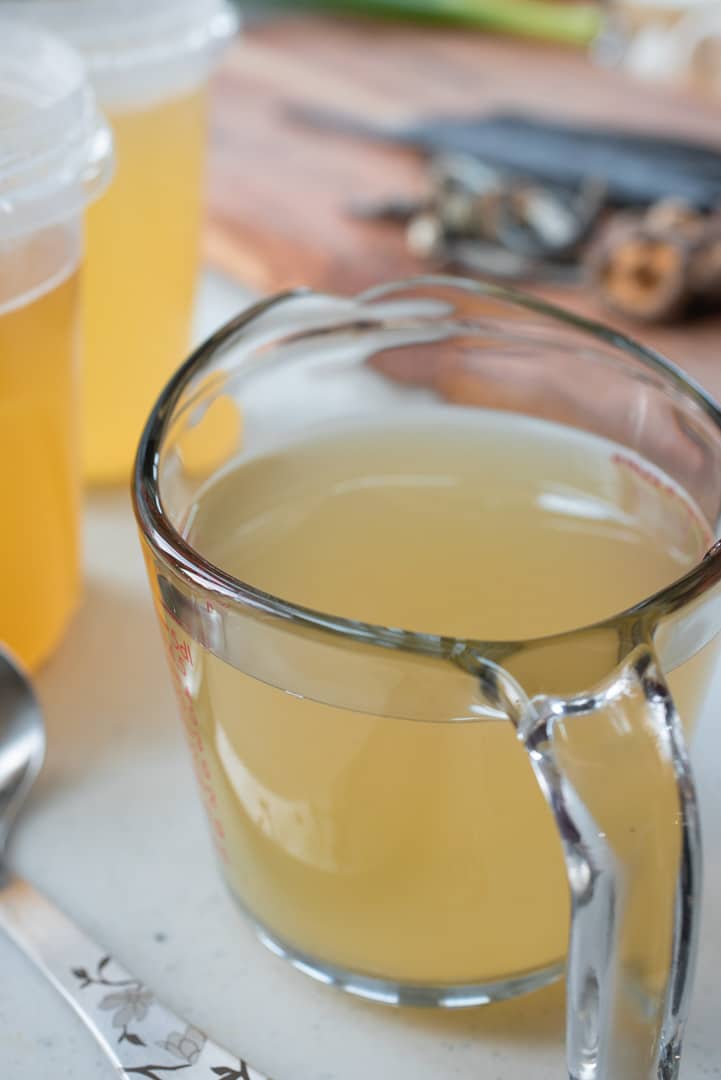
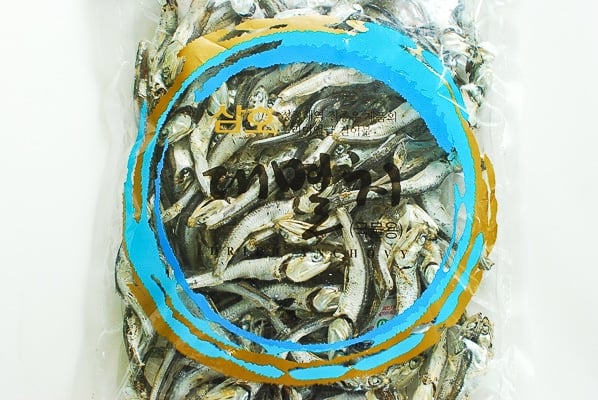
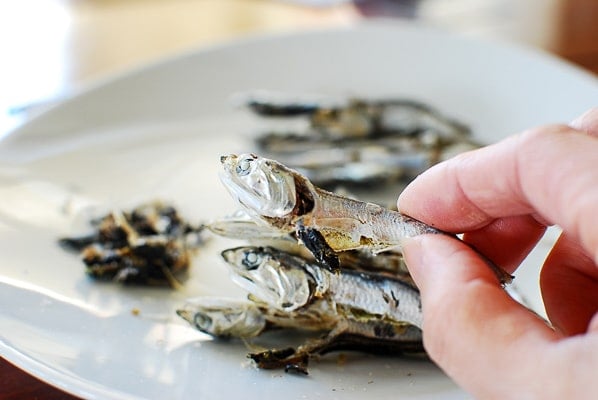
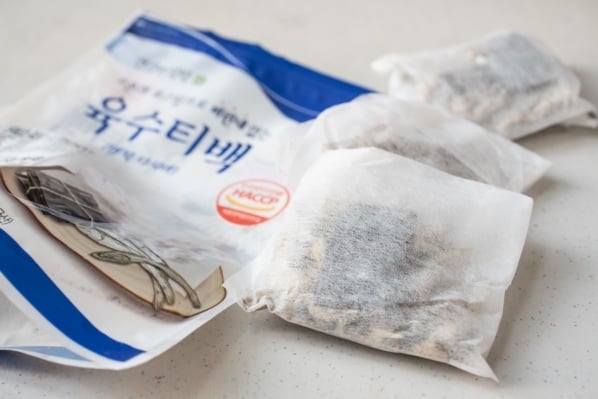
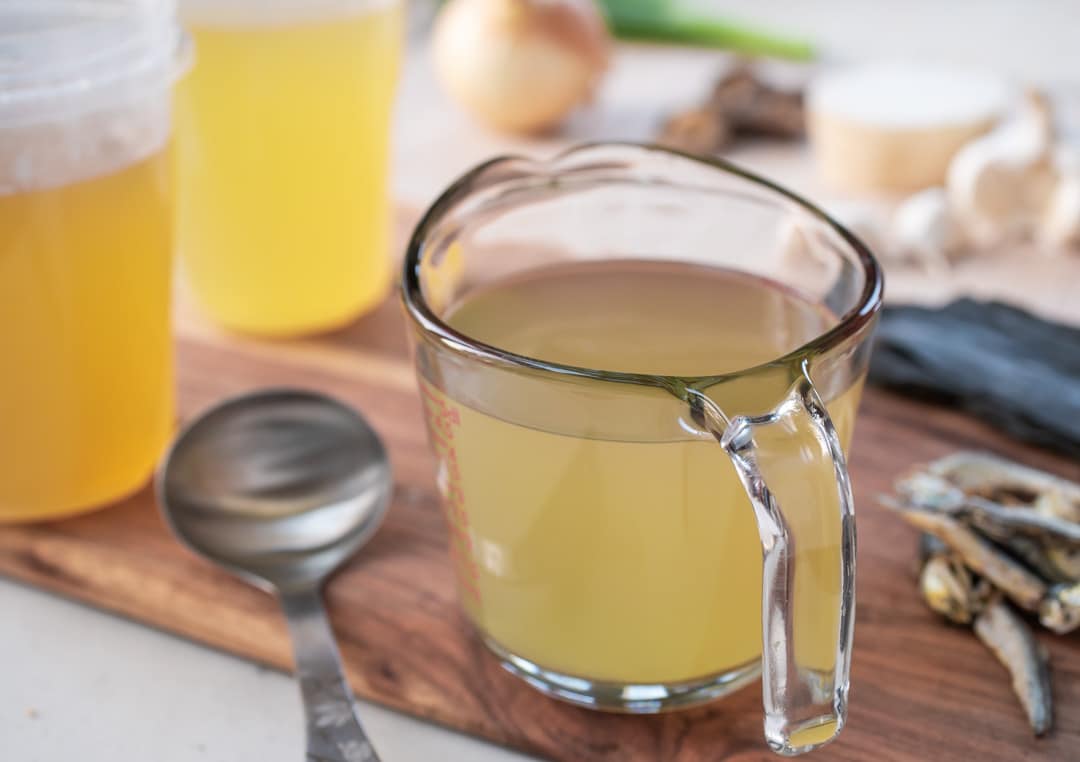
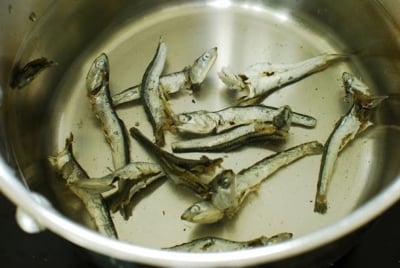
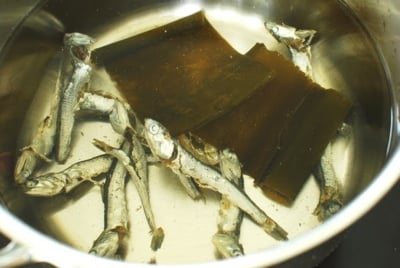
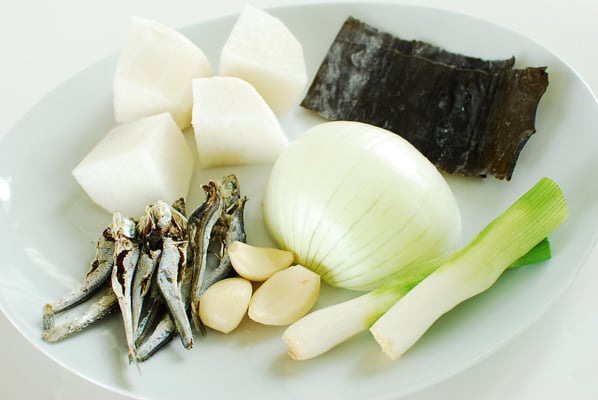
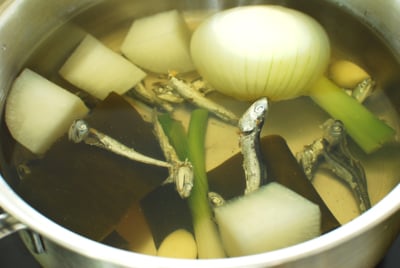
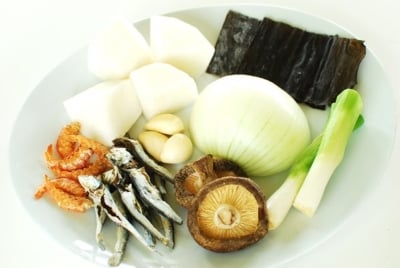
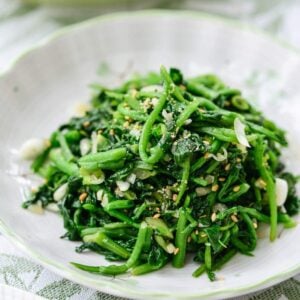

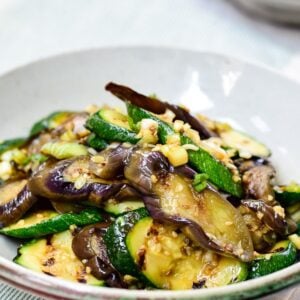
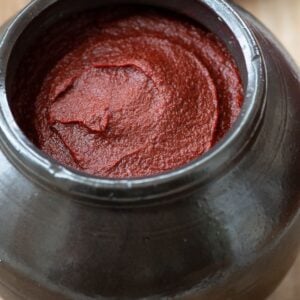













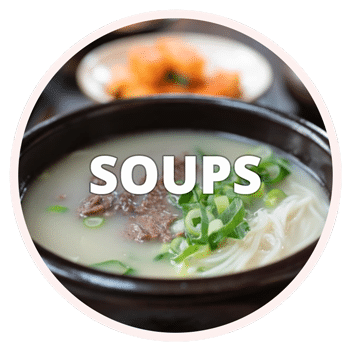



Elle says
I only have the small size dried anchovies. Could I increase the amount, or are they completely unsuitable for stock?
Hyosun says
Not ideal, but yes you can. The broth might not be as flavorful though unless you use a lot more.
Heidi says
I always have Korean anchovy powder on hand for making my Kim Chi, and thought I could sub this for the anchovies. What do you think? 1 teaspoon per cup of water? (Am making tteokbokki and need some anchovy broth). Appreciate any suggestions or tips! Cheers.
Laura says
Thank you so much for this recipe. It’s my go-to for soup bases. I usually make the fully flavored base as I normally have everything on hand. I do have the pouches when I’m feeling lazy though. I read a million blogs before I settle on a recipe but when it comes to anchovy broth I only use this one! And yes, our new local H-Mart is getting all of my money these days 🙂
Hyosun says
Great to hear! Thanks!!
Linda says
One suggestion I’d like to make although it may be a lot of extra work. It would really be nice to have weights for all ingredients since sizes like small, medium and large or counts don’t really mean that much. Or I may not have the ingredient in the mentioned size. I wouldn’t care whether US or metric was shown but something like that would be more precise. I see you use it for a few things.
I enjoy your site very much. I’ve just been getting into Korean cooking after spending months getting to know Chinese and Japanese. All such delicious food.
Traian says
Hi Hyosun from Romania – East Europa!
I’m very glad to found your food site. I like to try different cultures food. Unfortunate , in my town I can’t find koreean ingredients. No dried anchovies , kelp..etc Can I using frozen anchovies and dried them with a litle salt in a fruit dryer ? In stead of kelp can I use a dried green skin for making shusi ? Thank you very much for yours advices and especially for yours tasty and amazing recipes.
Hyosun says
Is that raw anchovies frozen? If they are, it sounds like a great idea. Korean anchovies are first cooked and dried. Seaweed sheets for sushi are not a good substitute for dried kelp. Just use what you can find, such as dried mushrooms, onions, etc. Hope this helps!
Nany says
Hi Hyosun, Your recipes literally make me drool. I’d love to prepare them all and I’m so curious about the taste of kimchi, however, for health reasons I cannot eat any hot/spicy food, no matter how much I’d like to. Is there a non-spicy kimchi recipe? And how can I make this delicious looking stew not spicy/hot? Thank you for sharing. Nany (I commented here since there wasn’t any other way to comment)
Karen says
For the anchovy packets photo that you included above (I believe it’s from Sumi Food), how much water do you need for 1 packet? I have exactly the anchovy packets from the picture but I can’t read the instruction since I cannot speak Korean 🙁
Hyosun says
Hmmm I don’t have that package any more, but I’d say 5 to 6 cups per packet.
Nadine sembrano says
Hi! Love this recipe! Just a question, after using the dried anchovies and kelp to make the stock, csn you reuse the anchovies and kelp for another batch? If so, how to best keep in the fridge and for how long?
Hyosun says
I wouldn’t recommend reusing the anchovies and kelp. They pretty much did their job so need to be thrown away. You can eat the kelp though. Has lots of fiber.
Joyce says
Was making Anchovy Stock III for my Army Stew.. I added pork bone, cabbage and carrots for more flavour.. turns out gd.. esp with dashima!
Sandra says
Thank you so much for posting this recipe. I usually don’t like to cook because when I see ingredients I am not familiar with, like anchovy broth, I just stay away from that recipe. Posting recipes like this helps so much with cooking. It makes people like me (someone who doesn’t like cooking) feel like cooking isn’t so bad after all.
I made this broth to make your Gyeranjjim recipe, and it made all the difference! It added a great flavor to the eggs that I usually don’t get. My family all loved it. Again, thank you!
Caroline C Chung says
Do you have cooking times for IP if you wanted to cook in the IP?
Hyosun says
I haven’t tried it in the Instant Pot, but the first two versions will be quicker over the stovetop. It will take that much time to have the pressure to build up. For the third option with hard vegetables, try cooking 15 minutes on Manual high. Hope this helps!
Stefania says
Awesome recipe! I can’t wait to try this as a soup base. A small request though, can you post a picture of the Dashima (kombu) packaging and the salted shrimp? One of the challenges for me as an american person is that when I go into H mart I have a hard time finding the things I need because I can’t read korean and the english on the package is sometimes limited.
I’m surprised they don’t sell anchovy stock pre-made. But I guess it wouldn’t be as awesome and fresh as making it at home
Yoonhee says
Why does dashima have to be removed after 10 minutes? I always wondered! I make the broth in my IP and leave it in the whole time. I don’t see any real difference (taste/texture/smell)?
Missy says
Can you use Anchovy paste to make broth if Anchovies are unavailable?
Hyosun says
hmmm I don’t know what kind of anchovy paste that is, but it’s not the same thing. Try it and see how it tastes. It might still add a good flavor to your broth.
Kira says
I am so happy I found this wonderful recipe. I was trying to make miso soup and this is perfect instructions. I bought some uncooked dried and frozen anchovies. I didnt realise you have to gut them. I was just wondering if its required to remove the guts because i can barelt get them out without the fish falling apart. Thanks so much
Betty Wilson says
My family missed the bulgogi we had often when we lived in Annandale, VA. I fixed your flank steak bulgogi last night last night and they loved it! I will be cooking more of your dishes soon.
Hyosun says
Awesome! I’m very happy to hear that. Hope you find many more recipes you and your family like.
Stefan Massong says
I will be making budae-jigae. I have a bottle of Korean anchovy fish sauce. Can I substitute the anchovy fish sauce for the anchovy stock? …. perhaps mix it with some water to dilute?
Tiffany says
Hello, I saw a different recipe that tells you to remove the anchovies’ heads as well. Do you know if that would that affect the stock’s flavor compared to not removing them? Thanks!
Hyosun says
It’s a matter of preference. It will not make a huge difference, but the head part does contribute to the flavor.
Daehyun says
Making iriko dashing tonight and it reminds me of being back in Korea. Ahhh I miss Korea!
Hyosun says
I do too!
Samuel says
Hello,
I wonder if there is a recipe for the leftover solid ingredients used for the broth like the anchovy, onion, garlic, shiitake mushrooms, and the kelp. It would be a waste if I threw them away. Would the Anchovy stir-fry works, if i add with more smaller anchovies?
Hyosun says
The anchovies won’t have much flavor left afterwards, but you can simply leave them in the dish you’re making with the broth if you want. I won’t recommend for stir-frying. You can also eat shiitake mushrooms and the kelp. Slice them up and drop them in the soup or stew you’re making.
Alexa says
Hi,
Thank you, this is a great recipe and I’ve used this in many dishes since learning it.
After making the stock, I throw away the cooked anchovies/dashima. I feel like this is wasteful.
Can you suggest some receipes for the cooked anchovies/dashima?
Thanks!!
Hyosun says
The anchovies won’t have any flavor afterwards, but you can keep them in the soup or stew you make with the broth if you like. The same with dashima.
Bea says
Hi , i really wanted to try this but i cant find kelp in the Philippines is there any substitute for kelp??
Hyosun says
Just omit it and use dried shiitake mushrooms if you have.
Neil says
안녕하세요 –
I have a question – if it is not possible to buy dried anchovies, is it possible to use anchovy seasoning “멸치 다시다”?
Hyosun says
Hi Neil – It will taste a little different, but you can use that if you want.
Renee Sadownyk says
Has anyone ever tried using Anchovy Paste to make the stock? That’s all I have at the moment.
Hyosun says
It would be completely different. What are you going to use the stock for?
Cindy says
Hi Hyosun,
Thank you for sharing your delicious recipes! I just wanted to know how much anchovy stock each of these recipes yield?
Hyosun says
Depending on which one you made and how much water you begin with, but it will reduce by about 1/4 to 1/3. Thank you for using my recipes!
Claudia says
Good Morning Hyosun,
So happy to find your website. I live in Germany and it was quite hard to find korean receipes. Well, not anymore…thanks to you.
I just have a question: After I have made the anchovy stock, but may I leave the anchovies in the stock?
Thank you for your help.
Hyosun says
Thank you, Claudia! I’m happy that you found my website! You can. They are not that tasty after releasing all the flavors, but certainly edible.
Halena says
Hi!
I am new to experimenting with Korean cooking for my Korean husband. 🙂
I just tried to make this stock with anchovies, kelp, onion and garlic with the intention of using it in dubu. I. followed the boiling instructions but the stock tastes literally like water. I wonder what I did wrong? I bought the large anchovies. Is it suppose to bring out flavor once in a dish or should it be more flavorful even just as s stock?
Hyosun says
It’s not supposed to be very strong, but it should have flavor – mild to deep, clean fish taste. Does the color look yellowish like the photo on this post? You can try to boil longer and/or use more anchovies if you like. Some anchovies are drier. Soaking in cold water for 20 to 30 minutes before boiling will also help. The anchovy broth should add a layer of flavor without overpowering the dish you’re making. Depending on what you’re using it for it could be light or more flavorful. Hope this helps, but let me know if you have any additional questions.
Halena says
Thanks! Maybe the anchovies were too dry. The color was very light yellow. I did soak them for 20 minutes. I will be more generous with the anchovies on my next try. I won’t give up! Just made your LA Kalbi and my girls couldn’t stop eating :). Thank you!
Hyosun says
That should work. Also you can soak longer. Buying good quality anchovies is important too. They keep well for long in the freezer. So very happy to hear your girls enjoyed LA kalbi. Cheers!
Judith Mopalia says
I have made these often, all versions, but mostly the fully flavored with optional ingredients. Thank you for teaching me such an excellent basis for my Korean cooking!
Hyosun Ro says
Sommer – Thanks!
Jen – That’s great! I am so happy to hear that. Thanks for trying out my recipes.
Judy – Oh I love all those Japanese dashi too. I know where to look when I want to make them – your blog, of course. Thanks.
Judy says
Love this post! Dashima sounds like the Japanese word “dashi” which means soup stock. I recently bought “instant” anchovy stock at the market and used it in place of the traditional katsuo (bonito) dashi and konbu (kelp) dashi that I typically use and I loved the flavor. Your technique for anchovy stock is very similar to how I make konbu/katsuo stock but I would have never known that the guts had to be removed from the dried anchovy. I like the idea of your fully flavored stock and would like to give that one a try with noodles as you suggested. Hope you’re having a great summer!
jen says
thank you! i just made this last night and then used your recipe for Doenjang Jjigae and my husband said my Doenjang Jjigae tasted a lot better! he’s not even Korean. LOL!
A SPICY PERSPECTIVE says
What a fantastic idea. 🙂
Hyosun Ro says
Kay, Pierre, Tammy and ginger and scotch: Thanks you very much for visiting and for the nice comments. Hope this post helps.
ginger and scotch says
thank you for this. I bought dried anchovies at a Korean market in Dubai with all intention of making stock. But after a year in my fridge and not knowing what to do with it….i had to throw it out. will give your instructions a try.
Tamar1973 says
Thanks for this recipe. Awesome!
PFx says
Sometimes when I was in Korea, I got left alone in the house. Then, all I had was TV and I just love flicking around to see people cooking. I definitely saw this stock being made.
Unfortunately, it’s impossible to find a decent anchovies in NZ.
In my mum’s Korean restaurant, she seems to use more of beef stock and not much of these, which is a little bit of a shame because I am a little bit less accustomed to this.
Kay Heritage says
LOVE soups made with anchovy stock!! Great post, Hyosun!